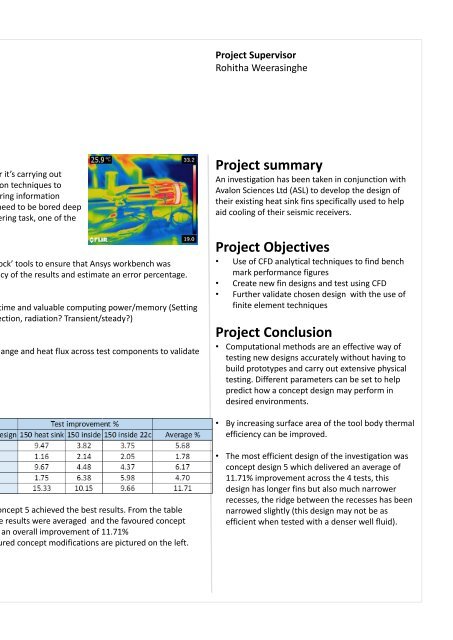UWE Bristol Engineering showcase 2015
Create successful ePaper yourself
Turn your PDF publications into a flip-book with our unique Google optimized e-Paper software.
Owain Robert Fullerton<br />
Mechanical <strong>Engineering</strong><br />
Project Supervisor<br />
Rohitha Weerasinghe<br />
Seismic receiver cooling fin development<br />
Seismic drilling has been around for many years and plays a crucial part in modern society. Whether it’s carrying out<br />
seismic surveys or drilling for fossil fuels there will always be a requirement to use proven exploration techniques to<br />
support energy and scientific projects. As technologies improve, methods and techniques for gathering information<br />
about this seismic world will change but the fundamental principles remain the same. Large holes need to be bored deep<br />
into the earth’s crust. Inevitably, problems will be encountered when taking on such a large engineering task, one of the<br />
difficulties being the extreme pressures and heat that the bore tool will be exposed to.<br />
For the initial stage of testing, experimental tests were carried out on basic geometries and provisional ‘mock’ tools to ensure that Ansys workbench was<br />
primarily being used correctly with the ideal setup. Also these preliminary tests help to validate the accuracy of the results and estimate an error percentage.<br />
This included;<br />
exporting from computer aided design software (CAD)<br />
Meshing the components to achieve highest realistic levels of accuracy without over computation to save time and valuable computing power/memory (Setting<br />
the analysis and mathematical models up to achieve highest levels of accuracy possible (conduction, convection, radiation? Transient/steady?)<br />
Use of Excel to calculate heat transfer coefficient for the fluid/solid interface<br />
Use of Excel to calculate wall film coefficient<br />
Use of Excel to carry out theoretical calculations of experiments to gain ball park figures of temperature change and heat flux across test components to validate<br />
CFD results<br />
Using acquired data to form graphs for ease of comparison and to evaluate initial findings<br />
Conclusion to analyse advantages and disadvantages and also to improve future testing methods.<br />
Project summary<br />
An investigation has been taken in conjunction with<br />
Avalon Sciences Ltd (ASL) to develop the design of<br />
their existing heat sink fins specifically used to help<br />
aid cooling of their seismic receivers.<br />
Project Objectives<br />
• Use of CFD analytical techniques to find bench<br />
mark performance figures<br />
• Create new fin designs and test using CFD<br />
• Further validate chosen design with the use of<br />
finite element techniques<br />
Project Conclusion<br />
• Computational methods are an effective way of<br />
testing new designs accurately without having to<br />
build prototypes and carry out extensive physical<br />
testing. Different parameters can be set to help<br />
predict how a concept design may perform in<br />
desired environments.<br />
• By increasing surface area of the tool body thermal<br />
efficiency can be improved.<br />
Design concept 5 achieved the best results. From the table<br />
above the results were averaged and the favoured concept<br />
achieved an overall improvement of 11.71%<br />
The favoured concept modifications are pictured on the left.<br />
• The most efficient design of the investigation was<br />
concept design 5 which delivered an average of<br />
11.71% improvement across the 4 tests, this<br />
design has longer fins but also much narrower<br />
recesses, the ridge between the recesses has been<br />
narrowed slightly (this design may not be as<br />
efficient when tested with a denser well fluid).


